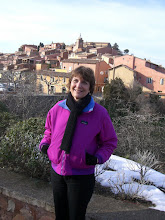
The series Laissez-vous conter (roughly translated as “Listen to the story”), presented by the tourist office at Carpentras, ended its two-week run on the last day of the region’s school vacation on Friday. A small group of about eight of us took advantage of a tour of l'Hôtel-Dieu (or “the general hospital”). Eighteenth century bishop Monseigneur d’Inguimbert, who figured prominently in reducing the size of the town’s synagogue, had two big projects in mind during his time as a church leader: the building of a library for all of the residents and a hospital for the poor. He accomplished both apparently, including this imposing edifice.

We began the visit, buffeted by the mistral, standing out in front of the former hospital. Our guide, Isabelle, told us that stone for the building was brought from nearby limestone quarries, but that unlike most other structures in the Vaucluse which are built with their back facing the north wind, the hospital was designed to benefit from the frequent air currents to clear toxic fumes--évacuer les miasmes--from the interior. She pointed out nice touches on the façade created by the architect Antoine d’Allemand: the angelots (“cherubs”) in the pediment above the second story whose legs and feet hang down in a very charming way and the four sculpted "masks" which stand for the four periods of life or the four seasons. Inside there are other attractive structural elements, like the staircases, les escaliers suspendus, which hang as if by magic to the hospital walls. It seems that at first some parishioners were none too happy about the building, saying it was too nice for the poor: trop beau pour les pauvres. But the bishop was convinced that the beauty of the surroundings was important for healing the sick.
Isabelle gave an interesting account of the history of the hospital. The St. Augustine nuns were responsible for the care of patients and of les enfants abandonnés (or “abandoned children”) who were left in something that resembles a kind of dumbwaiter. In the hall of la grande galérie there are framed paintings from as early as 1755 identifying les donatifs (“donors”) who provided funds to run the hospital. Two of the loveliest areas in the building, which seem to be untouched since the eighteenth century, are la chapelle and la pharmacie. The chapel, decorated in the Italian
 renaissance style, is made of red marble from the Languedoc region of France. Behind a grill on the right is le chœur (or “choir”) where the nuns used to sit while attending mass. On the left is the tomb of the bishop, ornamented with statues of two women, one standing for la Connaissance (“knowledge” because of his creation of the library) and the other la Charité (because of his charity in building a hospital for the poor). The pharmacy, which was run by another order of nuns (les sœurs de la Miséricorde), comprises several rooms: the laboratory where medications were made, an office which held hospital records, a library, and a boutique.
renaissance style, is made of red marble from the Languedoc region of France. Behind a grill on the right is le chœur (or “choir”) where the nuns used to sit while attending mass. On the left is the tomb of the bishop, ornamented with statues of two women, one standing for la Connaissance (“knowledge” because of his creation of the library) and the other la Charité (because of his charity in building a hospital for the poor). The pharmacy, which was run by another order of nuns (les sœurs de la Miséricorde), comprises several rooms: the laboratory where medications were made, an office which held hospital records, a library, and a boutique. The latter space is truly delightful: there are murals of cherubs (again indicating the four seasons--by way of flowers, wheat, grapes, and huddled around a fire) and
 amusing ochre renderings of monkeys making medicine on some of the cabinets. One scene shows un saigné, bleeding himself from his foot, in an attempt to get les quatre humeurs ("the four humors") into balance. In addition, the room has containers and pieces of built-in furniture kept in their original condition. Various sizes of pots and glasses, and over 160 drawers—some still containing flowers, powders, oils, waxes, creams, and pieces of bone and snakes—line the walls. Visiting the Hôtel-Dieu seemed like a real trip back in time.
amusing ochre renderings of monkeys making medicine on some of the cabinets. One scene shows un saigné, bleeding himself from his foot, in an attempt to get les quatre humeurs ("the four humors") into balance. In addition, the room has containers and pieces of built-in furniture kept in their original condition. Various sizes of pots and glasses, and over 160 drawers—some still containing flowers, powders, oils, waxes, creams, and pieces of bone and snakes—line the walls. Visiting the Hôtel-Dieu seemed like a real trip back in time.

3 comments:
The pottery vessels and the chest with the drawers in the pharmacie are beautiful. They seem to glow with the patina of age. Iam so glad "bleeding"s no longer practiced. I like to hold on to mine!!! Raise a glass of vin for me!
Yes, it was a very lovely place, that pharmacy. Please do hang on to your blood; we'll raise a glass to it and to you!
What else did "l'Hôtel-Dieu" do besides house orphans? I would love to know more about this place and also visit it as well it seems very interesting. I wish you had more pictures of this place and and the paintings there because it sounds very historic! Would you ever go back? Also would you ever take students to historic places such as this in France?
Post a Comment